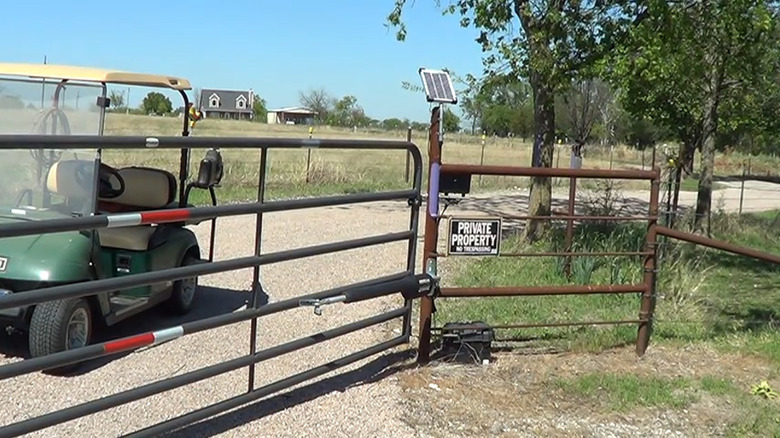There's An Important Reason For Those Purple Fence Posts You May See Around Town
The color purple has long been associated with royalty. Today, we're more familiar with its association with Barney (America's favorite purple dinosaur), the Minnesota Vikings, or the era of Prince's Purple Rain. It's also one of the least popular car colors in the United States. However, it's also a way to warn hikers and hunters to stay off a particular property. Way back in 1989, Arkansas was the first state to enact the "Purple Paint Law" as a cheap and easy way for landowners to identify their property without having to post "No Trespassing" signage, which is often shot at, stolen, or damaged by weather over time.
Spraying a swatch of purple on trees or fences easily communicates "keep out" without having to deal with replacing dilapidated signs, as paint can't be easily removed. The color was adopted because it wasn't used by the forestry industry, stands out in nature, and it's a pigmentation that can be seen by color blind people. More than 20 states have adopted this law, including Alabama, Arizona, Arkansas, Florida, Idaho, Illinois, Indiana, Iowa, Kansas, Louisiana, Maine, Maryland, Missouri, Montana, New Hampshire, North Carolina, Pennsylvania, South Carolina, Tennessee, Texas, Virginia, and West Virginia.
Nevertheless, restrictions do exist. In Pennsylvania, the law doesn't apply in Philadelphia and Allegheny counties. In other states, like North Carolina, purple means you can't hunt, fish, or trap on the property, as opposed to no trespassing. Still, other states use different colors entirely, such as orange, silver, yellow, red, and aluminum (Virginia). In Maryland, blue has been the standard color since 1989.
Warning: respect the purple paint
Most of the 20+ states with purple paint laws generally subscribe to the same basic criteria. Typically, the swatch of paint must be placed vertically and needs to be at least eight inches long and more than one inch wide. It also needs to be located at least three feet off the ground, but no higher than five feet.
In Alabama, if the paint is used on forest land, signage can't be more than 100 feet apart; however, on other types of land, it can be placed 1,000 feet apart, a rule followed by many other states. In 2020, Pennsylvania changed its state Crimes Code to permit the use of purple paint. Additionally, it made an exception that allows an unarmed individual to enter private property (even if they have signage or spray purple paint) if they need to retrieve their hunting dog.
As one would expect, the consequences of violating this "no trespassing" law, regardless of the color used, vary significantly from state to state. Often, it will include some kind of fine, but it could also involve a stint in jail. For instance, in Texas, you could face fines of up to $2,000 and up to six months in prison. In North Carolina (home to a great many military bases), trespassing could result in a misdemeanor (along with fines and jail time). While each state has slight variations, purple paint generally means "keep out" in some form or fashion. Ultimately, it's best to check with your local laws to ensure you know exactly which color is being used and what it means.
